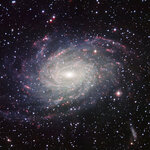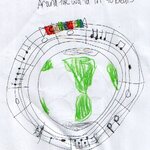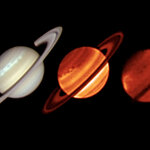Space
There are often heated discussions about the Big Bang. The Big Bang is well defined as the high density state that you get if you extrapolate the today observable cosmic Hubble expansion backward into the past. This definition has been the same one all along; it did not change; it is still valid today.
What does this entail?
1) The Big Bang tells you nothing about the absolute size of the universe at any time! As far as the definition is concerned, it may have been infinite all along. The Big Bang is not where the universe has zero size.
2) The Big Bang is similar (…

NASA historically has received 0.5% to 1% of the federal budget, a penny or less per dollar. I don't want to make that sound small-- I'd love a penny for every federal dollar-- but in terms of government programs, it's not the largest.
We all know the money goes to 'space stuff', but since that includes everything from airplane work (the first 'A' in NASA is Aeronautics, after all) through Earth observing and providing satellites for NOAA, up to deep space cosmology stuff. In the process, NASA invents and tests a heck of a lot of technology.
The bulk of NASA funding goes to…

The MPG/ESO 2.2-meter telescope has captured an image of NGC 6744, a spiral galaxy about 30 million light-years away in the southern constellation of Pavo (The Peacock).
And in the image, NGC 6744 looks a lot like our Milky Way.
We see NGC 6744 almost face on, meaning we get a bird’s eye view of the galaxy’s structure. If we had the technology to escape the Milky Way and could look down on it from intergalactic space, this view is close to the one we would see, striking spiral arms wrapping around a dense, elongated nucleus and a dusty disc. There is even a distorted companion galaxy —…

There is water inside the moon. A lot,
it turns out, according to the first measurements of water in lunar melt inclusions, which show that some parts of the lunar mantle have as much water as the Earth’s upper mantle.Lunar melt inclusions are tiny globules of molten rock trapped within crystals that are found in volcanic glass deposits formed during explosive eruptions. The new findings show lunar magma water contents are 100 times higher than previous studies have suggested.
The study is the culmination of years of investigation by the team searching for water and other volatiles in…

The rapid development of Mars, as little as two to four million years after the birth of the solar system (far more quickly than Earth) explains why it is so small by comparison, according to a new paper.
Mars probably is not a terrestrial planet like Earth, which grew to its full size over 50 to 100 million years via collisions with other small bodies in the solar system, says Nicolas Dauphas, a geophysicist at the University of Chicago. "Earth was made of embryos like Mars, but Mars is a stranded planetary embryo that never collided with other embryos to form an Earthlike planet."…

For our Calliope picosatellite mission, I want to make it a real space experience. That means it needs a mission patch. And first, let me thank you all-- our fans and community-- for ensuring our Kickstarter fundraiser made its goals! With less than 11 hours left, we hit our target figure! Woo! You're all awesome!
Contributors get a mission patch (or two, or six), and designing those mission patches is its own story. The motive was "every mission should have a mission patch", rooted deep in NASA tradition. Totally copying from LittleSDO, we have a…

Saturn may look like a nice place to visit through a telescope but once each Saturn year (that's 30 years to you and me) 'spring' arrives in the northern hemisphere of the giant planet and things go nuts.
"April showers bring May flowers" sounds lovely, but whoever said that has never been to Saturn. Nor have any of us, but you get the idea. We've detected six storms since 1876 but this is the first ever to be studied in the thermal infrared, which allows researchers to see the variations of temperature within a Saturnian storm and this was also the first to be observed by an…

Last night I had the pleasure to visit Mauro, a friend of mine and an amateur astronomer. Mauro owns a 24" dobson telescope with a mirror crafted by the superb hands of Romano Zen, the same who made my own 16". The precision of the optics of Romano is legendary, and as far as my limited capabilities allow me to judge, his reputation is entirely deserved. With my dobson scope I have been able, in nights of lucky seeing, to discern details on Jupiter of the order of half an arcsecond in angular extension. And with Mauro's 24"...
We had met to only observe Saturn -in fact the location and timing…
A few years ago, when 2% of astronomers decided Pluto should no longer a planet, the confusion was so great and the definition so arbitrary and so we now have five 'dwarf' planets in our solar system - Pluto, Ceres, Eris, Haumea and Makemake.
Tiny Haumea moves beyond the orbit of Neptune, has the shape of a flattened rugby ball and is around 2,000 km long. It spins completely in less than four hours, at one of the fastest rotation speeds in the Solar System. The precise orbits and sizes of Haumea are still not known (approximate scales of around 2,000 x 1,500 x 1,000…

With the discovery of so many new extrasolar planets, astronomers have observed that in some of these systems the star is spinning one way but the planet, a 'hot Jupiter',
a huge Jupiter-like planet in very close proximity to the central star, orbits the star in the opposite direction.
The proximity of these huge planets to their stars have made theoreticians and their flipped orbits have made theoreticians want to explain it - numerical models to the rescue. Using large-scale computer simulations, Frederic A. Rasio, a theoretical astrophysicist at Northwestern…